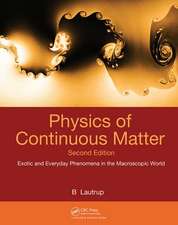Fundamentals of Multibody Dynamics: Theory and Applications
Autor Farid Amiroucheen Limba Engleză Hardback – 8 sep 2005
The book puts into perspective the importance of modeling in the dynamic simulation and problem solving in the above-mentioned fields. Facilitating the understanding of rigid- body dynamics, the author presents a compiled overview of particle dynamics and Newton’s second law of motion. A particular strength of the book is its use of matrices to generate kinematic coefficients that help formulate the governing equations of motion.
Preț: 913.26 lei
Preț vechi: 1113.74 lei
-18% Nou
Puncte Express: 1370
Preț estimativ în valută:
174.78€ • 181.79$ • 144.29£
174.78€ • 181.79$ • 144.29£
Carte tipărită la comandă
Livrare economică 14-28 aprilie
Preluare comenzi: 021 569.72.76
Specificații
ISBN-13: 9780817642365
ISBN-10: 0817642366
Pagini: 684
Ilustrații: XVI, 684 p.
Dimensiuni: 210 x 297 x 37 mm
Greutate: 1.08 kg
Ediția:2006
Editura: Birkhäuser Boston
Colecția Birkhäuser
Locul publicării:Boston, MA, United States
ISBN-10: 0817642366
Pagini: 684
Ilustrații: XVI, 684 p.
Dimensiuni: 210 x 297 x 37 mm
Greutate: 1.08 kg
Ediția:2006
Editura: Birkhäuser Boston
Colecția Birkhäuser
Locul publicării:Boston, MA, United States
Public țintă
Professional/practitionerCuprins
Particle Dynamics: The Principle of Newton’s Second Law.- Rigid-Body Kinematics.- Kinematics for General Multibody Systems.- Modeling of Forces in Multibody Systems.- Equations of Motion of Multibody Systems.- Hamilton-Lagrange and Gibbs-Appel Equations.- Handling of Constraints in Multibody Systems Dynamics.- Numerical Stability of Constrained Multibody Systems.- Linearization and Vibration Analysis of Multibody Systems.- Dynamics of Multibody Systems with Terminal Flexible Links.- Dynamic Analysis of Multiple Flexible-Body Systems.- Modeling of Flexibility Effects Using the Boundary-Element Method.
Recenzii
"This textbook offers a comprehensive exposition of contemporary multibody dynamics elaborated by an expert in and an experienced teacher of the field. There are five features that distinguish this publication: comprehensivity, orientation towards computer implementation, utilization of matrix algebra, teaching-by-examples methodology, and embedding in the author's own research accomplishments.... [T]his is an excellent textbook for undergraduate, graduate, and doctoral students of mechanical engineering, industrial physics and robotics; it may also be recommended as a reference text for researchers in these areas." —Mathematical Reviews
"This is a textbook intended for advanced undergraduate and beginning graduate students studying dynamics, physics, robotics, control, and biomechanics.... The book is well-written with good organization. It has good quality graphics. It clearly represents a considerable effort by the author to present a state-of-the-art exposition. The book should be of interest and use to practitioners and researches as well as students. It brings together methodologies from various fields into a single volume." —Zentralblatt MATH
"Timely and forward looking, Fundamentals of Multibody Dynamics, has immense potential for use as a textbook with a strong computer orientation towards the subject for junior/senior undergraduates and first-year graduate engineering students taking a course in dynamics, physics, control, robotics, or biomechanics. The work may also be used as a self-study resource or research reference for practitioners in the above-mentioned fields; they will find the book a refreshing break from the usual textbook presentation...with the type of printing, layout and illustrations by way of figures, tables and mathematical equations that contribute to a helpful understanding of the material presented and instant location of what isrequired by the reader. The book is studded with useful and relevant references. Thus, we are stronly led to recommend this impressive volume to students and practicing engineers who are looking for a book that fills the gap between dynamics and engineering applications. We have nothing but admiration for what Farid Amirouche has done." —Current Engineering Practice
"This is a textbook intended for advanced undergraduate and beginning graduate students studying dynamics, physics, robotics, control, and biomechanics.... The book is well-written with good organization. It has good quality graphics. It clearly represents a considerable effort by the author to present a state-of-the-art exposition. The book should be of interest and use to practitioners and researches as well as students. It brings together methodologies from various fields into a single volume." —Zentralblatt MATH
"Timely and forward looking, Fundamentals of Multibody Dynamics, has immense potential for use as a textbook with a strong computer orientation towards the subject for junior/senior undergraduates and first-year graduate engineering students taking a course in dynamics, physics, control, robotics, or biomechanics. The work may also be used as a self-study resource or research reference for practitioners in the above-mentioned fields; they will find the book a refreshing break from the usual textbook presentation...with the type of printing, layout and illustrations by way of figures, tables and mathematical equations that contribute to a helpful understanding of the material presented and instant location of what isrequired by the reader. The book is studded with useful and relevant references. Thus, we are stronly led to recommend this impressive volume to students and practicing engineers who are looking for a book that fills the gap between dynamics and engineering applications. We have nothing but admiration for what Farid Amirouche has done." —Current Engineering Practice
Textul de pe ultima copertă
Because of its versatility in analyzing a broad range of applications, multibody dynamics has grown in the past two decades to be an important tool for designing, prototyping, and simulating complex articulated mechanical systems. This textbook—a result of the author’s many years of research and teaching—brings together diverse concepts of dynamics, combining the efforts of many researchers in the field of mechanics. Bridging the gap between dynamics and engineering applications such as microrobotics, virtual reality simulation of interactive mechanical systems, nanomechanics, flexible biosystems, crash simulation, and biomechanics, the book puts into perspective the importance of modeling in the dynamic simulation and solution of problems in these fields.
To help engineering students and practicing engineers understand the rigid-body dynamics concepts needed for the book, the author presents a compiled overview of particle dynamics and Newton’s second law of motion in the first chapter. A particular strength of the work is its use of matrices to generate kinematic coefficients associated with the formulation of the governing equations of motion. Additional features of the book include:
* numerous worked examples at the end of each section
* introduction of boundary-element methods (BEM) in the description of flexible systems
* up-to-date solution techniques for rigid and flexible multibody dynamics using finite- element methods (FEM)
* inclusion of MATLAB-based simulations and graphical solutions
* in-depth presentation of constrained systems
* presentation of the general form of equations of motion ready for computer implementation
* two unique chapters on stability and linearization of the equations of motion
Junior/senior undergraduates and first-year graduate engineering students taking a course in dynamics, physics, control, robotics, or biomechanics willfind this a useful book with a strong computer orientation towards the subject. The work may also be used as a self-study resource or research reference for practitioners in the above-mentioned fields.
To help engineering students and practicing engineers understand the rigid-body dynamics concepts needed for the book, the author presents a compiled overview of particle dynamics and Newton’s second law of motion in the first chapter. A particular strength of the work is its use of matrices to generate kinematic coefficients associated with the formulation of the governing equations of motion. Additional features of the book include:
* numerous worked examples at the end of each section
* introduction of boundary-element methods (BEM) in the description of flexible systems
* up-to-date solution techniques for rigid and flexible multibody dynamics using finite- element methods (FEM)
* inclusion of MATLAB-based simulations and graphical solutions
* in-depth presentation of constrained systems
* presentation of the general form of equations of motion ready for computer implementation
* two unique chapters on stability and linearization of the equations of motion
Junior/senior undergraduates and first-year graduate engineering students taking a course in dynamics, physics, control, robotics, or biomechanics willfind this a useful book with a strong computer orientation towards the subject. The work may also be used as a self-study resource or research reference for practitioners in the above-mentioned fields.
Caracteristici
Numerous worked examples at the end of each section Inclusion of MATLAB-based simulations and graphical solutions; presentation of the general form of equations of motion ready for computer implementation Two unique chapters on stability and linearization of the equations of motion











